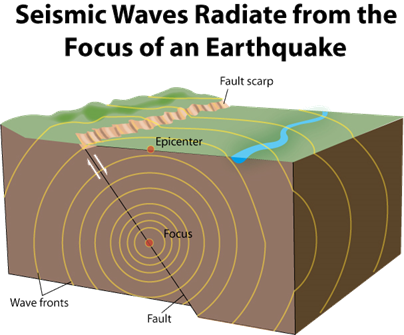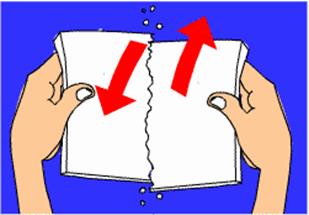OUR
DYNAMIC EARTH
WHAT
CAUSES MAJOR GEOLOGICAL EVENTS?
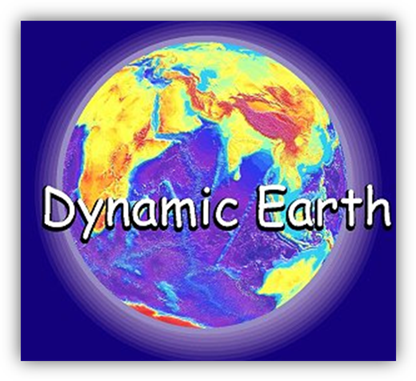
Unit
Overview
This unit develops the idea that most major geological events result from plate motion. As the crustal plates move about, cracks in the crust allow magma to flow up and eventually form new landmasses. The pressure in these moving plates is released through the crust as earthquakes.
|
GLOSSARY
OF KEY TERMS |
|||
|
crust |
plate
tectonics |
seismic
waves |
vents |
|
epicenter |
seismology |
longitudinal
waves |
lava |
|
mantle
plume |
surface
wave |
transverse
waves |
focus |
|
volcanoes |
hot spot |
Richter
scale |
|
|
seismograph |
seismologists |
|
|
Earthquakes
Earthquakes happen daily, but not all earthquakes are felt by people or damage our buildings. Look at the map below. It is a record of all the earthquakes that took place in 1998.
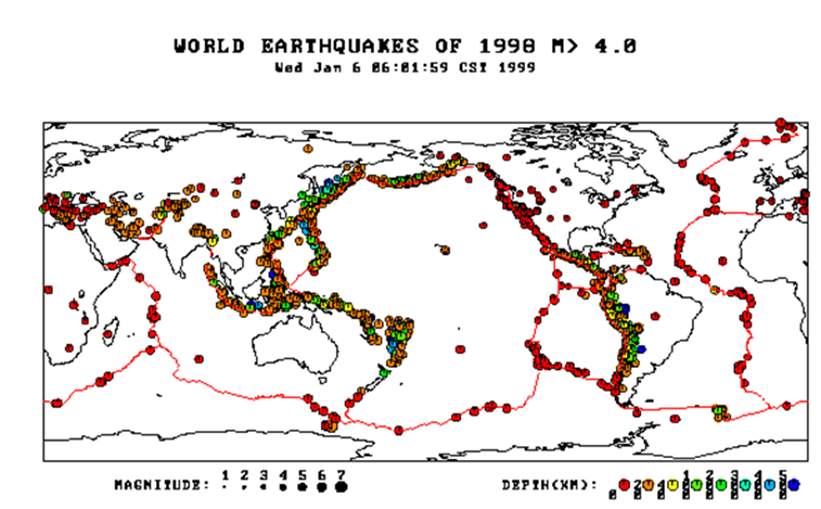
Surprisingly, this many earthquakes could happen in one year. Many were shallow and very mild, so they were only noticed by sensitive scientific equipment that measures such events. One crucial observation can be made by looking at the map; earthquakes seem to follow a pattern. They often occur in the same areas over and over. This unit will look at major geological events such as earthquakes and volcanoes and how our Earth's structure contributes to their occurrences.
What
are Earthquakes?
· The motion felt by scientific equipment and occasionally by people is the built-up energy of plate motion traveling through solid rock. The energy travels as waves. These waves are called seismic waves.
· As plates push against each other, energy builds up and causes stress on the plates. Eventually, the stress breaks off a rock at fault lines, and the energy is released through and along the surface of the Earth, and we experience the shaking of an earthquake. We need to look closely at these waves of energy to understand earthquakes.
The Energy of Seismic Waves
· A seismic wave will carry the energy released by the break in the rock of the lithosphere. The area where the rock initially breaks is called the focus. This is where the earthquake originates. The energy travels in all directions from the focus. The focus is usually deep within the Earth. The area on the surface directly above the focus is called the epicenter. This is usually the area on the surface where most of the damage done by an earthquake occurs.
· The energy released by an earthquake is measured as a shock wave. Scientists measure these waves in shock-wave recording stations with a seismograph machine. The study of earthquakes is called seismology, and the scientists who study them are called seismologists.
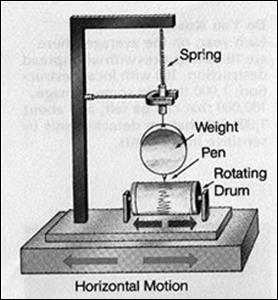
· There are three types of waves created by an earthquake.
1. The first is a longitudinal wave, which begins at the quake's focus. These waves travel quickly and reach the seismograph before any other wave types. Because of this, they are also called P waves (primary waves). These waves compress the Earth's crust in front of the wave and stretch the crust out behind the wave. Primary waves (or P waves) are the fastest moving waves, traveling 1 to 5 miles per second (1.6 to 8 kilometers per second). They can pass through solids, liquids, and gases easily. As they travel through rock, the waves move tiny rock particles back and forth -- pushing them apart and back together -- in line with the direction the wave travels. These waves typically arrive at the surface as an abrupt thud. The longitudinal wave can be compared to stretching out a spring and releasing it.
2. The second type of wave is a transverse wave. Transverse waves also originate at the focus of the earthquake. Since this type of wave arrives after the P waves, it is called an S wave (secondary wave). Secondary waves would resemble shaking a rope up and down from one end. They move slowly as P waves and can only pass through solids. As S waves move, they displace rock particles outward, pushing them perpendicular to the path of the waves. This results in the first period of rolling associated with earthquakes. Unlike P waves, S waves don't move straight through the Earth. They only travel through solid material and are stopped at the liquid layer in the Earth's core.
3. The third type of wave is called a surface wave. Surface waves cause the most damage to buildings because they contain both a back and forth motion and an up and down motion. Unlike body waves, surface waves (also known as long waves or simply L waves) move along the surface of the Earth. Surface waves are to blame for most of an earthquake's carnage. They move up and down the surface of the Earth, rocking the foundations of manufactured structures. Surface waves are the slowest moving of all waves, which means they arrive the last. So the most intense shaking usually comes at the end of an earthquake.
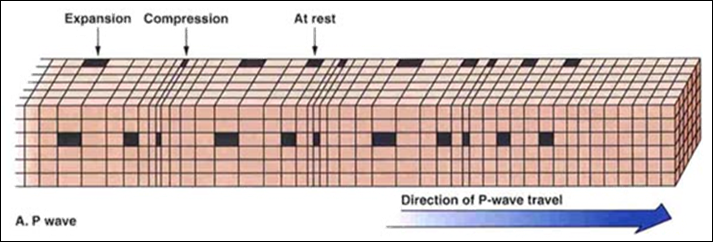
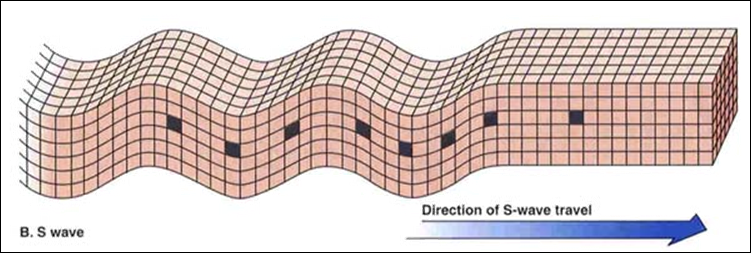
|
EARTHQUAKE
ACTIVITY |
|
|
Materials: |
1. 12 inch
by 12 inch piece of Styrofoam 2. Piece
of loose leaf to record your results. |
|
|
|
|
Procedure:
|
1. Break
the piece of Styrofoam in half. 2. Set the
two pieces of foam down on a table with the two rough edges facing each
other. 3. Push
the Styrofoam together with a light amount of pressure, but then move them
against each other as plates would move at a transform fault. |
|
|
|
|
1. Record
your observations. |
|
|
2. Repeat
the procedure, but each time apply more pressure. |
|
|
Now
explain how this experiment is related to the events of an earthquake. |
|
Volcanoes
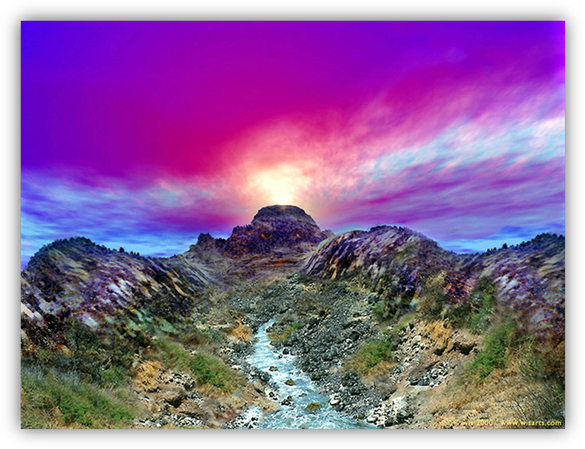
· Volcanoes are an opening in the Earth's crust through which magma can reach the Earth's surface. The openings are called vents. Volcanoes can form hills and mountains as they erupt over the years.
· There are several types of volcanoes. The type of magma and eruption usually classifies volcanoes. Magma that reaches the Earth's surface is called lava.
· Lava rich in magnesium and iron is very fluid and flows for a great distance. The eruptions from this type of volcano are usually mild and may occur many times. The lava will cool and harden to produce a gently sloping hill or mountain. This is called a shield volcano. Mount Loa in Hawaii is a shield volcano.
· Some volcanic flows will form alternating ash, cinders, and lava layers. The magma is rich in silica and is thicker than a shield volcano. Gases can get trapped and build up in the magma. After the pressure gets so great, the volcano will erupt with lava flows and explosions of ash and cinders. The gases are very toxic to people and animals. This type of volcano is a composite volcano. Composite volcanoes are usually taller with steeper slopes than shield volcanoes. Mount St. Helen's in the state of Washington is a composite volcano. It violently erupted in 1980, causing much damage and killing 57 people.
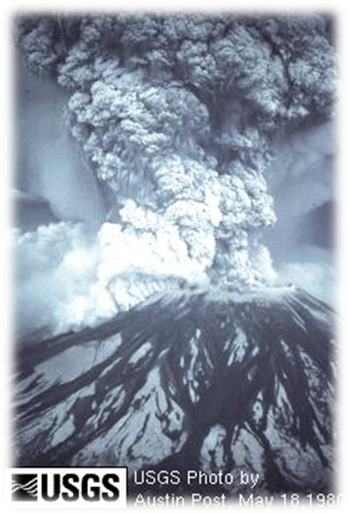
· Most volcanoes are cinder cones. They are the largest group of volcanoes. This type of volcano is usually active for a short time. Gases are trapped in the magma, and then a violent eruption occurs. These eruptions spew ashes and cinder in significant quantities.
· The particles fall to the ground around the vent and form a cone. Paricutin in Mexico is a cinder cone volcano.
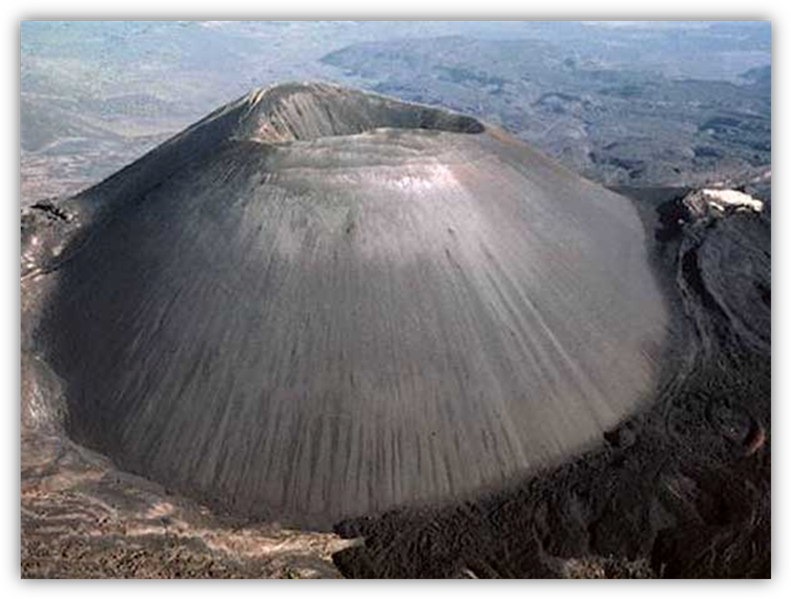
· Volcanoes can also form underwater as well as on dry land. Underwater volcanoes are called seamounts. Seamounts look like composite volcanoes and can form ash and steam clouds above the water level.
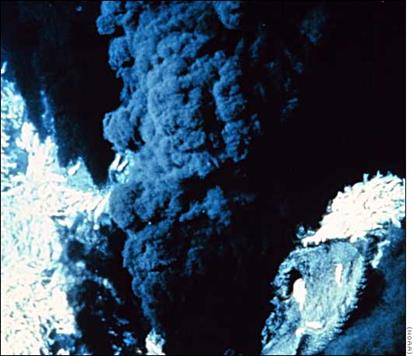
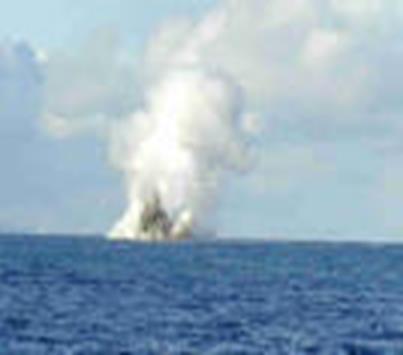
· Volcanoes occur in predictable locations. They are linked to plate movement. Volcanoes will appear in three specific locations.
1. Convergent plate boundaries: As one plate sinks underneath another, the magma can work its way to the surface. The famous Ring of Fire volcanoes lies in this type of boundary.
2. Divergent Plate Boundaries: As plates move away, a gap is widened, allowing magma to rise. This type of volcano usually appears along the mid-Atlantic Ridge.
3. Hot Spots: Hot spots can occur in the middle of plates. Hot magma will push into the crust to form a mushroom-shaped trail. This is called a mantle plume. The plume continues to push against the crust until it can break the surface and cause a volcanic eruption. Many island chains, including the Hawaiian Islands, are formed this way. The magma plume continues to move under the ocean floor and erupts along the way, forming individual islands.
For additional information on the volcanic rim around the Pacific Ocean, click on the Volcanoes Around the Pacific Ocean PDF File. This information will help you answer question #18.
Experiment
Time!
|
Build a Working Volcano |
|
In this
experiment we build a real working volcano. The experiment is based on a
vinegar and baking soda reaction, so it will be a bit messy. The experiment
should be done with adult supervision, but is safe and uses household
ingredients. |
|
Materials: 1.
Salt
dough 2.
Plastic
soda bottle 3.
Baking
pan 4.
Red
food coloring 5.
Liquid
detergent 6.
Baking
soda 7.
Vinegar |
|
First we need to create the “salt
dough”. |
|
Mix 6 cups
flour, 2 cups salt, 4 tablespoons cooking oil, and 2 cups of water in a large
bowl. Work the ingredients with your hands until smooth and firm. Add more
water to the mixture if needed. |
|
Second: Build the volcano |
|
Stand the
soda bottle in the baking pan. Mold the salt dough around the bottle making
sure you don't cover up the bottle mouth or drop any dough into the bottle.
Take your time on this step and build your volcano with as much detail as you
like. |
|
Third: Have some fun! |
|
Fill the
bottle most of the way with warm water mixed with a little of the red food
coloring. Put 6
drops of the liquid detergent into the bottle. Add 2
tablespoons of baking soda. Slowly
pour vinegar into the bottle and jump back quick! Notice the
red 'lava' that flows out of your volcano. This happens because of the baking
soda and vinegar mixture. Mixing baking soda and vinegar produces a chemical
reaction in which carbon dioxide gas is created - the same gas that bubbles
in a real volcano. The gas bubbles build in the bottle, forcing the liquid
'lava' mixture of the bottle and down the sides of your volcano. |
VOCABULARY
STUDY SUGGESTION: Make vocabulary flash cards. Put the word on one card and the definition on another card. Play a matching game and match the vocabulary word with its definition.
crust: the outermost and thinnest layer of Earth
epicenter: the point on Earth's surface directly above the focus of an earthquake
fault: a crack in Earth created when rocks on either side of a break move
focus: the area along a fault at which slippage first occurs, initiating an earthquake
lithosphere: the thin outer shell of Earth, consisting of the crust and the rigid upper mantle
magma: the molten rock within Earth
mantle: the layer of rock between Earth's crust and its core
P waves: primary waves; the longitudinal waves generated by an earthquake
plate tectonics: the theory that Earth's surface is made up of large moving plates
Richter scale: a scale that expresses the relative magnitude of an earthquake
S waves: secondary waves; the transverse waves generated by an earthquake
seismology: the study of earthquakes and related phenomena
subduction: the process in which a tectonic plate dives beneath another tectonic plate and into the asthenosphere
surface waves: the seismic waves that travel along Earth's surface
vent: an opening through which molten rock flows onto Earth's surface
